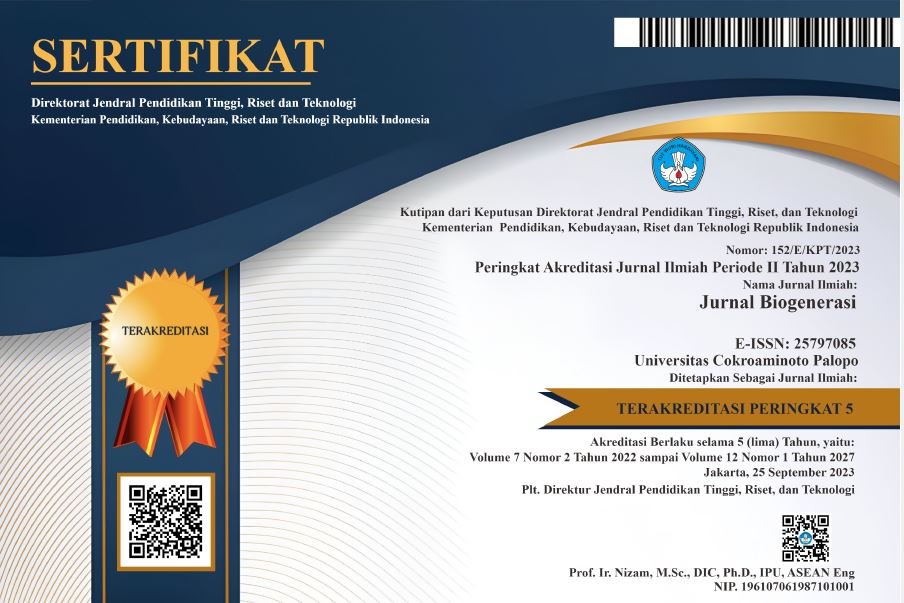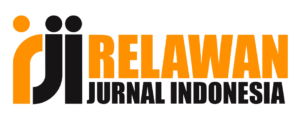Analisis Kesulitan Belajar Biologi Siswa Kelas X MAN 1 Mamuju
DOI:
https://doi.org/10.30605/biogenerasi.v10i2.5510Keywords:
analysis of learning difficulties, factors of learning difficultiesAbstract
This research aims to analyze the level of learning difficulty of class X MAN 1 Mamuju students in odd semester biology material. The type of research is quantitative survey method research with 167 samples determined using census techniques. The research instruments are biology learning results tests, questionnaires and observation sheets. The research data was analyzed by calculating the average and percentage and then categorizing it. Based on the research results, the majority of students experienced learning difficulties out of the 167 students who were the research samples. Biology test material to determine learning difficulties consists of Biology and its Role in Life with an average score of 84, Viruses and their Role in Life with an average score of 73, Prokaryotic Organisms and their Role in Life with an average score of 63, Protista and their Role in Life with an average score of 43, Kingdom Fungi and their Role in Life with an average score of 57. The factors that cause students' learning difficulties consist of internal and external factors. The internal factor that causes learning difficulties with the highest negative answer is the fatigue factor at 76.05% and the external factor that causes learning difficulties with the highest negative answer is the community factor at 70.51%. The highest negative answer was for the sub-indicator of internal factors, namely spiritual factors, while the lowest negative answer was physical disability at 17.37%, then the sub-indicator with the highest negative answer for external factors was the form of life in society at 78.44%, while the lowest average negative answer was school time at 45.51%.
Downloads
References
Ahmadi.A., & Supriyono, 2013, Psikologi Belajar, Jakarta : Rineka Cipta
Arifin.Z., (2012), Evaluasi Pembelajaran, Bandung : Rosdakarya
Aunurrahman, (2014), Belajar dan Pembelajaran, Bandung : Alfabeta
Diki, D. (2013)., Creativity for Learning Biology in Higher Education. LUX: A Journal of Transdisciplinary Writing and Research from Claremont Graduate University, Vol. 3(3).
Dimyati.M., & Mudjiono, (2009), Belajar dan Pembelajaran, Jakarta : Rineka Cipta
Dimyati.M., (2012), Psikologi Pendidikan, Bandung : CV Pustaka Setia
Djamarah & Zain, (2013), Strategi Belajar Mengajar, Jakarta : Rineka Cipta
Fathurrahman.M., (2015), Model-Model Pembelajaran Inovatif, Yogyakarta : AR-Ruzz Media
Fauziyah E., (2022), Relationship Between Learning Motivation and Learning Difficulties for Class XI Students at SMA BU NU Bumiayu, Jurnal Guiding World, Vol.5 (2)
Gusnarib & Rosnawati, (2021), Teori-teori Belajar dan Pembelajaran, Indramayu : CV Adanu Abimata
Hamalik.O., (2007), Proses Belajar Mengajar, Jakarta : Bumi Aksara
Jamaris.M., (2014), Kesulitan Belajar: Perspektif. Asesmen, dan Penanggulangannya Bagi Anak Usia Dini dan Usia Sekolah. Bogor: Ghalia Indonesia
Lestari.I., (2015), Pengaruh Waktu Belajar dan Minat Belajar Terhadap Hasil Belajar Matematika, Jurnal Formatif, Vol.3 (2)
Lusiana. & Hutahaean, B. (2019). Analisis Kesulitan Belajar Siswa dalam Pembelajaran Bahasa Indonesia Sesuai Kurikulum 2013 di SMP Santo Thomas 3 Medan, Jurnal Pendidikan Bahasa Indonesia dan Sastra (PENDISTRA), Vol. 2(2).
Magdalena, M. (2020). Meningkatkan Prestasi Belajar dalam Pendidikan Modern. Jakarta: PT Pustaka Raya.
Mayer.R.E., 2022, The Science of Learning: Making the Most of What We Know, USA : Yale University Press
Muhammedi, dkk, (2017) Psikologi Belajar, Medan : Larispa Indonesia
Mulyadi, (2010), Diagnosis Kesulitan Belajar dan Bimbingan Terhadap Kesulitan Belajar Khusus. Yogyakarta : Nuha Litera
Mulyadi, (2010), Evaluasi Pendidikan Pengembangan Model Evaluasi Pendidikan Agama Di Sekolah, UIN : Maliki Press
Nurjan, Syarifan, (2016), Psikologi Belajar, Ponorogo : Wade Group
Nurlina, dkk, (2022), Buku Ajar Belajar dan Pembelajaran, Bandung : Widina Bhakti Persada Bandung
Ormrod & Jeanne, (2014), Human Learning, USA : Pearson
Purwanto, (2010), Evaluasi Hasil Belajar, Yogyakarta : Pustaka Belajar
Pane.A., Dasopang.M.D., 2017, Belajar dan Pembelajaran, Jurnal Kajian Ilmu-ilmu Keislaman, Vol. 3 (2)
Reid.G., (2016), Dyslexia : A Practitioner’s Handbook John, Sussex : British Library
Rumini, Irham, dan Wiyani.A.N., (2013), Psikologi Pendidikan, Yogyakarta : Ar-Ruzz Media
Sabri.A., (2007) Psikologi Pendidikan, Jakarta : Pedoman Ilmu Jaya
Sambas.M.S., (2017), Faktor Internal dan Eksternal Pembelajaran, Jurnal Tarbiya Islamica, Vol.5 (2)
Septiani.,P., (2018), Analisis Kesulitan Belajar Siswa Dalam Menyelesaikan Soal Jurnal Penyesuaian Pada Mata Pelajaran Ekonomi, Jurnal Neraca, Vol.2 (2)
Slameto. (2015). Belajar dan Faktor-Faktor Yang Mempengaruhinya. Jakarta : PT. Rineka Cipta
Smith.L., & Renzulli.J., (2010), Learning Disabilities and Giftedness : Identification and Interventions, Journal of Educational Psychology, Vol.48 (2)
Suardi.M., (2018), Belajar dan Pembelajaran, Yogyakarta : Deepubish
Sugihartono. (2007). Model Pembelajaran Inovatif serta Penerapannya pada SD/SMP CI-BI. Semarang: Rajawali
Sugihartono, (2015), Psikologi Pendidikan, Yogyakarta : UNY Press
Sujarweni,V. Wiratna, (2018), Metodologi Penelitian Bisnis dan Ekonomi Pendekatan Kuantitatif. Yogyakarta: PSTAKABAPUPRESS.
Supatminingsih.T, (2020), Belajar dan Pembelajaran, Jurnal Syariah dan Hukum, Vol.16 (2)
Yamin, M. (2013) Staretgi & Metode dalam Model Pembelajaran. Jakarta: Gaung Persada Press
Yuni, A. (2023), Mengenal Kesulitan Belajar Pada Siswa SMA, Jurnal Ilmu Pendidikan, Vol.7 (1)
Downloads
Published
How to Cite
Issue
Section
License
In submitting the manuscript to the journal, the authors certify that:
- They are authorized by their co-authors to enter into these arrangements.
- The work described has not been formally published before, except in the form of an abstract or as part of a published lecture, review, thesis, or overlay journal.
- That it is not under consideration for publication elsewhere,
- That its publication has been approved by all the author(s) and by the responsible authorities – tacitly or explicitly – of the institutes where the work has been carried out.
- They secure the right to reproduce any material that has already been published or copyrighted elsewhere.
- They agree to the following license and copyright agreement.
License and Copyright Agreement
Authors who publish with this journal agree to the following terms:
- Authors retain copyright and grant the journal right of first publication with the work simultaneously licensed under Creative Commons Attribution License (CC BY 4.0) that allows others to share the work with an acknowledgment of the work's authorship and initial publication in this journal.
- Authors are able to enter into separate, additional contractual arrangements for the non-exclusive distribution of the journal's published version of the work (e.g., post it to an institutional repository or publish it in a book), with an acknowledgment of its initial publication in this journal.
- Authors are permitted and encouraged to post their work online (e.g., in institutional repositories or on their website) prior to and during the submission process, as it can lead to productive exchanges, as well as earlier and greater citation of published work.


.png)

